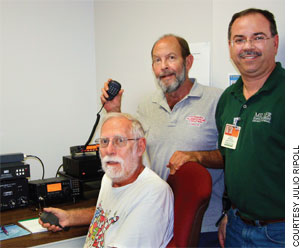Wireless Lifeline
By Maya Bell
 |
| Ham radio teams relayed crucial information and helped save lives during the Haiti crisis. |
With the Internet down and cell and satellite phone service spotty, doctors at the University of Miami Hospital in Haiti needed a reliable way to order supplies and coordinate the arrival of replacement volunteers.
Fortunately they had the world’s oldest, and still most dependable, wireless technology just 25 yards outside the tent hospital’s pediatric ward: the ham radio station Ronald Bogue, assistant vice president for facilities and services, and UM alumnus Julio Ripoll established to provide communications between the hospital at the Port-au-Prince airport and the Global Institute/Project Medishare’s Haiti Relief Task Force on the Miller School campus.
 |
| John McHugh, Dale Botwin, and Julio Ripoll, volunteers at the National Hurricane Center’s ham radio station, set up UM’s ham station on the Miller School campus. |
Bogue never dreamed, though, that Haiti's WX4NHC, an offshoot of the ham station Ripoll founded at the National Hurricane Center as an architecture student 30 years ago, would evolve into a vital lifeline.
Yet, during WX4NHC’s month in Haiti, ham radio volunteers coordinated dozens of patient transfers to the U.S. Navy hospital ship USNS Comfort, connected doctors at remote clinics with University specialists for emergency consults, conveyed landing coordinates for helicopter pilots conducting medical evacuations, and rounded up urgently needed supplies and equipment— including incubators for premature babies and food for children stranded at an isolated orphanage.
“It was beyond our wildest expectations,” Bogue said. “I had no idea it would morph into what it became.”
 |
| Volunteers Louis Cruz and Jack Satterfield erected the station at UM’s field hospital in Haiti and were the first of five teams to coordinate communications for the relief effort. |
Indeed, the Haiti station proved essential on the February 3 afternoon that two doctors at the University hospital asked operator Jack Satterfield to help a 13-year-old girl who would die without surgery they were unequipped to perform. Thirty minutes later, the girl was aboard one of the Comfort’s speedboats, racing for the vessel.
“We contacted the Comfort for authorization to transport,” Satterfield wrote in a situation report detailing WX4NHC’s role. “The Comfort sent a fast boat to the port. We got the girl to the port in less than 30 minutes. The doctor said she would have died if this didn’t happen.”
Satterfield, a military auxiliary radio system, or MARS, operator and charter boat captain from Pinellas County, and Louis Cruz, an IT specialist who volunteers at the hurricane center’s ham station in West Miami-Dade County, were the first of five ham radio teams to deploy to Haiti. In less than two days, they set up 300 pounds of equipment, half of it donated by the American Radio Relay League. Cruz then modified a VHF radio to access marine frequencies, giving the station a direct link to the Comfort and instantly expanding its role.
 |
| In action at the microphone, Ripoll, who founded the hurricane center station as a UM student, was the driving force behind UM’s Haiti station 30 years later. |
“The primary goal was to provide backup communications for the University if the satellite link failed,” said Ripoll, who earned his UM architecture degree in 1981. “But it quickly became the coordinator of communications among military, medical, and non-governmental relief organizations.”
A designer of medical labs and clinics, Ripoll had worked with Bogue on numerous Miller School projects, so Bogue was familiar with the architect’s hobby and solicited his help. “Julio immediately took the ball and ran with it,” Bogue said.
For Ripoll and the other volunteers who rotated into a disaster zone—on vacation time and at their own expense—the rewards outweighed all the sacrifices.
As Satterfield wrote about the 13-year-old girl: “She is stable and doing well...Makes it all worthwhile.”
|


